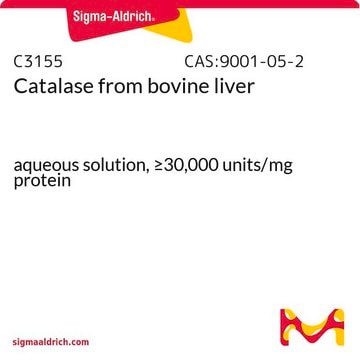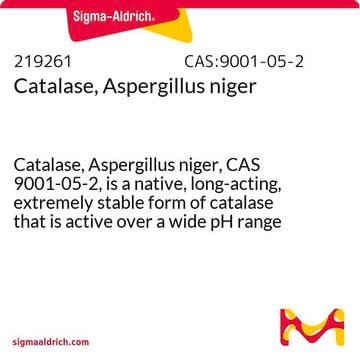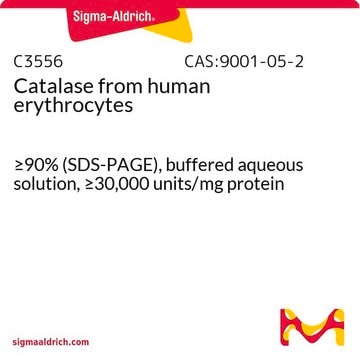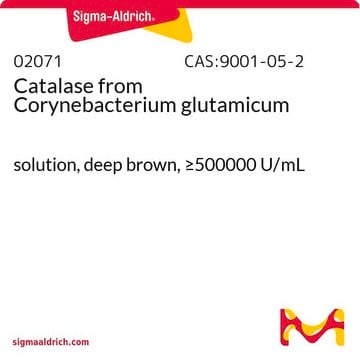C30
Catalase from bovine liver
aqueous suspension, 10,000-40,000 units/mg protein
Sinónimos:
Bovine hepatocatalase, H2O2:H2O2 oxidoreductase
About This Item
Productos recomendados
biological source
bovine liver
form
aqueous suspension
specific activity
10,000-40,000 units/mg protein
mol wt
tetramer ~250 kDa
concentration
20-50 mg/mL
technique(s)
GC/MS: suitable
isoelectric point
5.4
UniProt accession no.
shipped in
wet ice
storage temp.
2-8°C
InChI
1S/C9H10O3/c1-2-12-9(11)7-3-5-8(10)6-4-7/h3-6,10H,2H2,1H3
InChI key
NUVBSKCKDOMJSU-UHFFFAOYSA-N
Gene Information
cow ... CAT(280743)
¿Está buscando productos similares? Visita Guía de comparación de productos
General description
Research area: Cell Signaling
Catalase from bovine liver is a tetramer consisting of 4 equal subunits each with a 60 kDa molecular weight. Each of these subunits contains iron bound to a protoheme IX group. The enzyme will also strongly bind to NADP, where NADP and the heme group are within 13.7 angstroms.
application
- Dielectrophoretic field-flow fractionation (DEP-FFF): It is a chromatographic method in which cell elution times reflect the positions of cells in a hydrodynamic flow profile under the control of sedimentation, DEP and hydrodynamic lift forces, FSED, FDEP and FHDL, respectively. The DEP-FFF buffer consists of catalase along with other ingrediants.
- GC-MS analyses.
- Deionization.
- GC-FID analysis.5
- Functional analysis of blood vessel.
Catalase from bovine liver may be used:
- to prepare H2O2-O2 based biocathode for applications in glucose biofuel cells
- to study the kinetic properties and storage stability of catalase immobilized on to florisil
- in glutathione-mediated superoxide generation in an aqueous solution
Biochem/physiol Actions
Caution
Unit Definition
Preparation Note
Storage and Stability
persons
antibody
inhibitor
related product
signalword
Danger
hcodes
pcodes
Hazard Classifications
Resp. Sens. 1
Storage Class
13 - Non Combustible Solids
wgk_germany
WGK 1
flash_point_f
Not applicable
flash_point_c
Not applicable
ppe
Eyeshields, Gloves, multi-purpose combination respirator cartridge (US), type N95 (US)
Certificados de análisis (COA)
Busque Certificados de análisis (COA) introduciendo el número de lote del producto. Los números de lote se encuentran en la etiqueta del producto después de las palabras «Lot» o «Batch»
¿Ya tiene este producto?
Encuentre la documentación para los productos que ha comprado recientemente en la Biblioteca de documentos.
Los clientes también vieron
Nuestro equipo de científicos tiene experiencia en todas las áreas de investigación: Ciencias de la vida, Ciencia de los materiales, Síntesis química, Cromatografía, Analítica y muchas otras.
Póngase en contacto con el Servicio técnico











